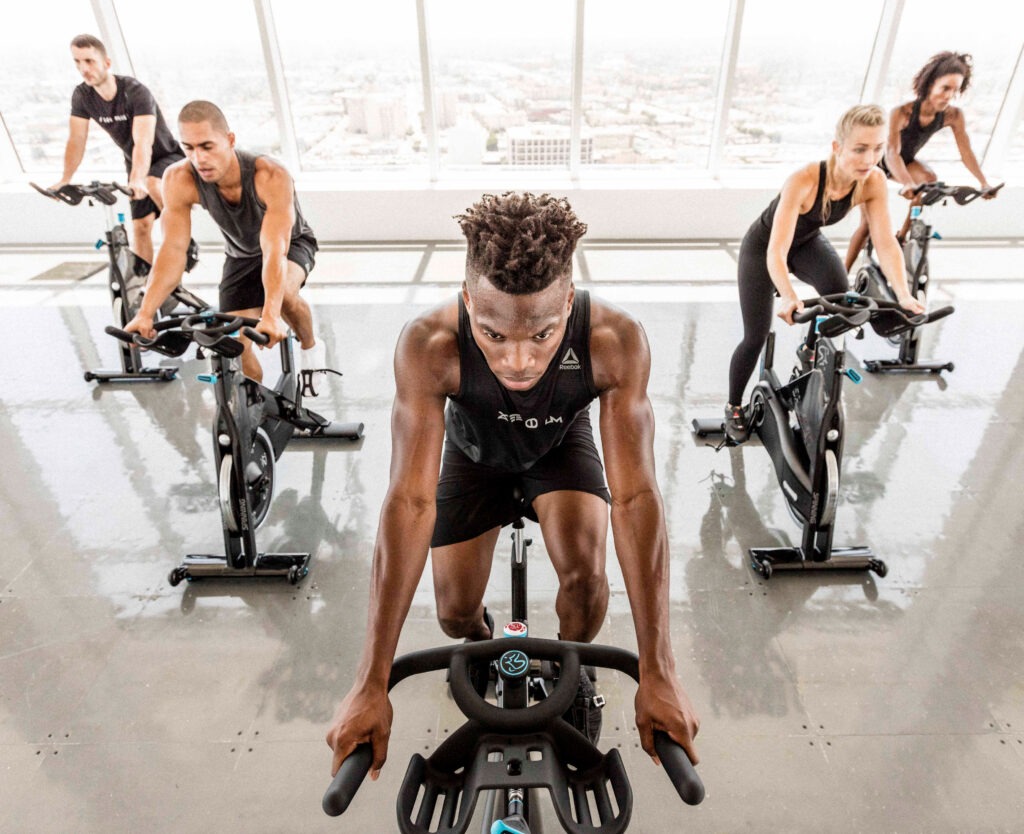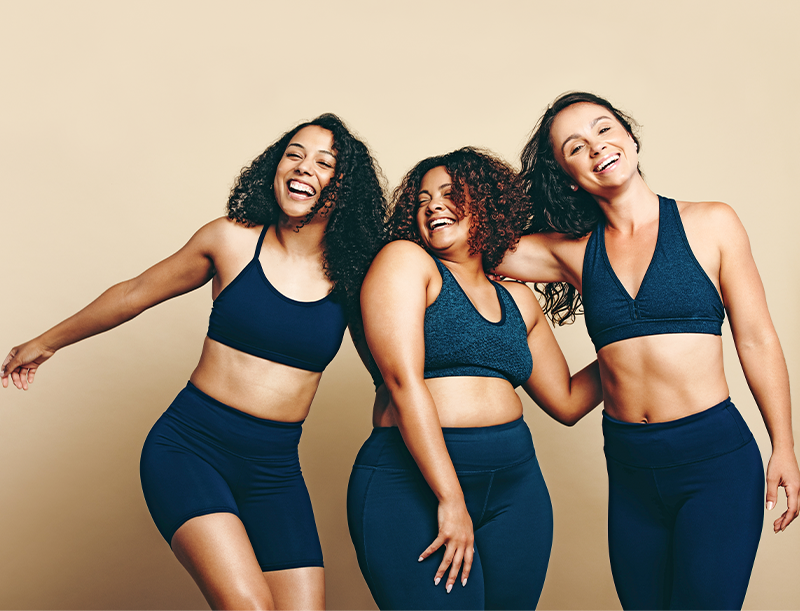Indoor cycling trends
Back in the saddle

Let’s jump straight to the punchline, shall we?
Amid what’s being dubbed a global “live revival” – fitness fans flocking back to gyms and health clubs post-lockdown, seeking greater motivation and social connection after months of solitary home workouts – indoor cycling is enjoying its own revival.
From fifth most popular group exercise format in 2018, indoor cycling has leapt up the ranks to claim second place in 2021, favoured by 30 per cent of group exercise participants and sitting just behind HIIT (31 per cent). Note, too, that these figures are global; in the US, UK and China, indoor cycling is the #1 class format.
These are just some of the stats from the Les Mills 2021 Global Fitness Report, published in September and sharing insights from 12,157 consumers across five continents.
“Those who do cycle classes attend their club more frequently than non-class gym members: 4 versus 3.5 times a week”
Creating good habits
Indoor cycling being on the global group exercise podium was, of course, already music to the ears of all of us at RIDE HIGH – but we didn’t want to stop there. Instead, we asked the Les Mills team to dig a little deeper into the data to see what else they could tell us about indoor cycling.

What really grabbed our attention was the fact that indoor cycle class users have ‘better’ behaviours compared to other gym-goers. The differences might be small, yet cycling consistently comes out on top.
Those who do cycle classes attend their club more frequently than non-class gym members (4 times a week versus 3.5 times a week). They also have slightly longer gym tenure (3 years) than those who do other class formats (2.8 years), or who don’t take part in classes at all (2.7 years).
Cycle class participants also do very slightly more classes a week (3.4, including but not necessarily exclusively cycling) than those who don’t cycle at all (3.3 classes a week).
In terms of all-round exercise habits, indoor cyclists also exercise more frequently than participants of other class types (4.9 versus 4.7 times a week on average, with these figures including all forms of in- and out-of-club exercise).
It’s also great that cycling extends all of this to males as well as females, with men more likely to take part in indoor cycling than other types of class: 52 per cent of cycle participants are male, versus an average 44 per cent across other class types.
“Lockdown has spawned a new generation of fitness fans: 27 per cent of regular exercisers describe themselves as absolute beginners”
Shifting priorities
Priorities have also changed over the last three years, although this isn’t unique to indoor cyclists.
Back in 2018, the top three things class participants looked for across the board were quality of instructor, time of day and type of class. Now, although quality of instructor is still the #1 priority, music comes second – up from sixth place in 2018 – followed by quality of equipment, up from 10th place.
The latter two priorities are particularly marked among indoor cyclists, who are more likely to look for quality music than those doing other classes (27 versus 23 per cent) and quality equipment (25 versus 21 per cent).

This has major implications for operators, who must acknowledge they are now catering for members seeking a quality experience, not simply a convenient workout.
Another interesting equipment-related finding is this: that in spite of the far larger price tag, a stationary bike is the third most popular piece of home fitness equipment, after dumbbells at #1 and yoga mats at #2.
Let’s now set all of this against the backdrop painted by the Les Mills report – one in which the pandemic has changed fitness habits potentially forever, with key trends emerging that will shape workouts in the years to come.
Growth opportunities
The pandemic has prompted consumers to prioritise their health, presenting fitness providers with growth opportunities as clubs return to full capacity.
Among Les Mills survey respondents, 50 per cent say they are now focusing more on their wellbeing than pre-COVID. An impressive 82 per cent say they regularly exercise, or plan to do so soon, and 75 per cent of this group do gym-type activities. Club visits per member are also up 10 per cent in markets where restrictions are no longer in place.
Lockdown has also spawned a new generation of fitness fans who have taken tentative first steps into fitness and are now deciding what comes next, with 27 per cent of regular exercisers describing themselves as ‘absolute beginners’.

Opportunities abound for operators who can appeal to these groups and understand the unique barriers they face: although 81 per cent of beginners are interested in group activities, 66 per cent say they currently prefer to exercise alone, suggesting a confidence chasm that needs to be bridged before beginners feel fully comfortable.
“Indoor cyclists are significantly more likely to look for quality music and quality equipment than those doing other types of class ”
Instructors and club teams have a key role to play in ensuring beginners feel welcome, while helping them find their intrinsic motivation to exercise that will be key to their long-term adherence.
Live revival
After a year of enforced home workouts, appetite for live fitness experiences in groups is soaring: two-thirds of gym members (67 per cent) say they prefer working out in groups, 85 per cent say they’re interested in trying live classes in their facility, and live fitness classes are the single most popular gym-type activity (29 per cent of members).
Meanwhile, at the time of the Les Mills research, class attendance had reached 119 per cent of pre-COVID levels in markets where capacity restrictions had lifted, with live classes in club nearly twice as popular as livestream classes at home (favoured by 44 versus 23 per cent of members respectively).
The human touch
With consumer desire for social connection driving the live revival, it’s perhaps inevitable that clubs’ own people have a vital role to play. As noted previously, rockstar instructors are the single most important factor for gym-goers when choosing a live class: 28 per cent of all participants name this as a priority. Rockstars are also key to driving referrals.
Having great people is also particularly important for winning new members: 30 per cent of prospects say ‘a good atmosphere’ is key when choosing a gym to join – pushing ‘the facilities’ into fourth place – while 59 per cent say the staff are a key factor.

Connected fitness
After the rapid digitalisation of fitness during lockdown, it will come as no surprise that omnichannel fitness – a blend of in-gym and digital home workouts – is tipped to gain traction as we emerge from the pandemic: 59 per cent of exercisers say they now favour a 60:40 split between gym and home workouts.
Far from being simple stop-gaps to tide the industry over during the COVID pandemic, livestream and on-demand have become vital additions to clubs’ long-term digital offerings, with 80 per cent of members planning to continue using them post-pandemic.
“Class attendance has reached 119 per cent of pre-COVID levels in markets where capacity restrictions have lifted”
Live fitness experiences may remain the pinnacle – 62 per cent still do more than half their workouts at the gym – but the digital fitness boom and the growth of home-working mean today’s fitness consumers demand a connected fitness experience that offers convenience and enables them to maintain a more active lifestyle. The evidence? A whopping 84 per cent of gym members also work out at home, and digital fitness users exercise 22 per cent more frequently than live-only exercisers.
Seamlessly linking live and digital will be key to clubs’ success moving forward.
Quality as a USP
In a world of endless quantity – especially online, with the likes of YouTube chock-full of free-to-use, often pretty average fitness content – it’s never been more vital to focus on quality. Operators need to provide world-class content, both in and out of club, to keep members engaged and willing to pay.
With this in mind, it’s important to understand member preferences, and Les Mills found 86 per cent of group exercisers prefer branded classes. Meanwhile 62 per cent say the quality of the music, instructors, equipment and choreography are key to deciding which classes they attend.

Also note that 58 per cent of members say they would likely cancel their membership if their gym took away their favourite class.
Workplace wellness
Employers are increasingly coming to recognise the benefits of an active workforce – and their responsibility to support this – while employees are gravitating towards companies that care. This creates lucrative opportunities for omnichannel fitness providers to proffer their services and reach new audiences.
For clubs, the ability to demonstrate the scientifically proven impact of their workouts will be key to winning in the workplace wellness market, where ROI carries great weight among decision-makers.
Download your complimentary copy of the Les Mills 2021 Global Fitness Report here.
Video

Conceived, powered and funded by BODY BIKE®, RIDE HIGH has a simple mission: to celebrate and champion the very best of indoor cycling, sharing ideas, stories and experiences from around the world to inspire the sector on to even bigger and better things. Subscribe for free by leaving your details below and we'll send indoor cycling's hottest news direct to your inbox three times a year.






